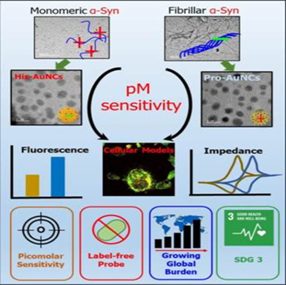

27th August 2025 (18 Topics)
Context:
Researchers at INST, Mohali, have developed a gold nanocluster–based biosensor for early detection of Parkinson’s disease.
Parkinson’s Disease (PD):
- PD is one of the fastest-growing neurological disorders globally.
- It involves progressive degeneration of dopaminergic neurons, leading to motor and non-motor symptoms.
- Diagnosis generally occurs only after considerable neuronal loss, making early detection critical.

Key Protein – ?-synuclein:
- In PD, ?-synuclein undergoes misfolding and aggregation.
- Normal form is harmless (monomeric), while aggregated form (amyloid) is toxic and damages brain cells.
Nanotechnology Application – Gold Nanoclusters (AuNCs):
- Ultra-small fluorescent particles (few nanometers wide).
- Amino acid–capped nanoclusters (Proline-coated ? normal protein; Histidine-coated ? toxic protein aggregates).
- Used to distinguish between physiological and pathological protein conformers.
Techniques Used:
- UV-Vis spectroscopy, fluorescence imaging, TEM, XPS.
- Gel electrophoresis, fluorescence quenching, cyclic voltammetry, impedance spectroscopy.
- Tested in SH-SY5Y human neuroblastoma cells to validate biosafety and effectiveness.
Institutional Framework:
- Research carried out at Institute of Nano Science and Technology (INST), Mohali, under the Department of Science and Technology (DST).
- Collaboration with CSIR-Institute of Microbial Technology (IMTECH), Chandigarh for protein biochemistry and cell-based assays.
Significance:
- Provides a label-free, low-cost, clinically adaptable biosensor for early detection of PD.
- Potential extension to other protein-misfolding diseases like Alzheimer’s.
- Supports India’s focus on affordable healthcare, nanotechnology, and biotechnology innovation.
More Articles

